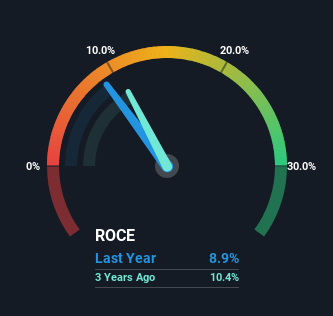- China
- /
- Semiconductors
- /
- SHSE:600667
Investors Met With Slowing Returns on Capital At Wuxi Taiji Industry Limited (SHSE:600667)

Did you know there are some financial metrics that can provide clues of a potential multi-bagger? Ideally, a business will show two trends; firstly a growing return on capital employed (ROCE) and secondly, an increasing amount of capital employed. Put simply, these types of businesses are compounding machines, meaning they are continually reinvesting their earnings at ever-higher rates of return. However, after briefly looking over the numbers, we don't think Wuxi Taiji Industry Limited (SHSE:600667) has the makings of a multi-bagger going forward, but let's have a look at why that may be.
What Is Return On Capital Employed (ROCE)?
Just to clarify if you're unsure, ROCE is a metric for evaluating how much pre-tax income (in percentage terms) a company earns on the capital invested in its business. The formula for this calculation on Wuxi Taiji Industry Limited is:
Return on Capital Employed = Earnings Before Interest and Tax (EBIT) ÷ (Total Assets - Current Liabilities)
0.089 = CN¥974m ÷ (CN¥31b - CN¥20b) (Based on the trailing twelve months to March 2024).
Therefore, Wuxi Taiji Industry Limited has an ROCE of 8.9%. In absolute terms, that's a low return, but it's much better than the Semiconductor industry average of 3.9%.
View our latest analysis for Wuxi Taiji Industry Limited

Above you can see how the current ROCE for Wuxi Taiji Industry Limited compares to its prior returns on capital, but there's only so much you can tell from the past. If you'd like, you can check out the forecasts from the analysts covering Wuxi Taiji Industry Limited for free.
So How Is Wuxi Taiji Industry Limited's ROCE Trending?
Over the past five years, Wuxi Taiji Industry Limited's ROCE and capital employed have both remained mostly flat. It's not uncommon to see this when looking at a mature and stable business that isn't re-investing its earnings because it has likely passed that phase of the business cycle. With that in mind, unless investment picks up again in the future, we wouldn't expect Wuxi Taiji Industry Limited to be a multi-bagger going forward.
Another point to note, we noticed the company has increased current liabilities over the last five years. This is intriguing because if current liabilities hadn't increased to 65% of total assets, this reported ROCE would probably be less than8.9% because total capital employed would be higher.The 8.9% ROCE could be even lower if current liabilities weren't 65% of total assets, because the the formula would show a larger base of total capital employed. So with current liabilities at such high levels, this effectively means the likes of suppliers or short-term creditors are funding a meaningful part of the business, which in some instances can bring some risks.
Our Take On Wuxi Taiji Industry Limited's ROCE
In a nutshell, Wuxi Taiji Industry Limited has been trudging along with the same returns from the same amount of capital over the last five years. Since the stock has declined 18% over the last five years, investors may not be too optimistic on this trend improving either. All in all, the inherent trends aren't typical of multi-baggers, so if that's what you're after, we think you might have more luck elsewhere.
If you'd like to know about the risks facing Wuxi Taiji Industry Limited, we've discovered 1 warning sign that you should be aware of.
For those who like to invest in solid companies, check out this free list of companies with solid balance sheets and high returns on equity.
Valuation is complex, but we're here to simplify it.
Discover if Wuxi Taiji Industry Limited might be undervalued or overvalued with our detailed analysis, featuring fair value estimates, potential risks, dividends, insider trades, and its financial condition.
Access Free AnalysisHave feedback on this article? Concerned about the content? Get in touch with us directly. Alternatively, email editorial-team (at) simplywallst.com.
This article by Simply Wall St is general in nature. We provide commentary based on historical data and analyst forecasts only using an unbiased methodology and our articles are not intended to be financial advice. It does not constitute a recommendation to buy or sell any stock, and does not take account of your objectives, or your financial situation. We aim to bring you long-term focused analysis driven by fundamental data. Note that our analysis may not factor in the latest price-sensitive company announcements or qualitative material. Simply Wall St has no position in any stocks mentioned.
Have feedback on this article? Concerned about the content? Get in touch with us directly. Alternatively, email editorial-team@simplywallst.com
About SHSE:600667
Wuxi Taiji Industry Limited
Primarily engages in the semiconductor packaging and testing business.
Flawless balance sheet with high growth potential and pays a dividend.
Market Insights
Community Narratives



